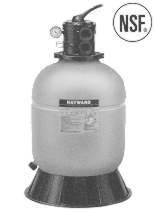SAND FILTER
OPERATION & TROUBLE SHOOTING
 The oldest and most popular method of
filtration is the sand filter. The high-rate sand filter was introduced more than thirty
years ago and the only type of sand filter currently used for residential pools. They come
in all sizes and shapes.
The oldest and most popular method of
filtration is the sand filter. The high-rate sand filter was introduced more than thirty
years ago and the only type of sand filter currently used for residential pools. They come
in all sizes and shapes.
All sand filters share a couple of features, when in the filtration mode, water always
flows from the top down and they all have some sort of lateral or underdrain designed with
slots or holes to hold back sand while allowing the clean, water to pass through.
Outward appearance of filters and internal assemblies may vary, but, basically all sand
filters operate the same way. Sand is added to the filter through a top valve or domed
opening in the tank or by removing a cover. Vertical standpipes must be covered by a
protective cap (a baggie or a coffee can will do) to keep from getting sand into the
internal plumbing.The sand should be poured gently into the filter, being sure not to
damage the laterals or underdrain. A good practice is to add enough water to cover the
laterals or underdrain , because this will cushion the falling sand. On top-mount filters,
be sure the lateral assembly is positioned properly into the center of the tank before
pouring in the sand. Various guides are used to insure that the assembly is properly set,
because improper seating of the vertical standpipe will prevent the valve from seating
properly and may require that you remove all of the sand to reset it. Holding the top of
the standpipe down while pouring the sand will prevent it from dislodging.
Once the proper amount of sand is added, the protective cap should be removed and the
valve or dome mounted in place. Some valves thread into the top of the tank, others are
held by clamp. All valves use some sort of O-ring as a seal. A liberal amount of O-ring
lubricant should be applied to both the O-ring and the external threads to allow the valve
to seat properly. On flange mount valves, this lubrication will allow adjustment once the
clamp is semi-tightened. Be sure the lubricant is non-aggressive to plastic or rubber.
Sand filters use a special filter sand, normally .45 mm to .55, which is also known as
pool grade #20 silica sand. The special sand has sharp edges that serve to separate
particles, allowing filtration to take place. once the proper amount of sand has been
added to the filter, it functions as the permanent dirt removing medium. Water from the
pool, containing suspended dirt particles, is pumped through the piping system and is
directed automatically by a filter control valve to the top of the tank. As the pool water
is pumped down through the filter tank through the control valve and back to the pool
through the piping system. his entire sequence is continuous and automatic and provide for
total recirculation of the pool water. After a period of time, the accumulated dirt in the
filter causes a resistance to flow, and the flow diminishes. This simply means that it is
time to backwash (clean) the filter. With the control valve in the backwash position, the
water flow is reversed through the filter so that it is directed to the bottom of the tank
and up through the sand, thus flushing the previously trapped dirt and debris out the
waste line. Once the filter is backwashed , the control valve is re-sequenced manually to -rinse-
and then to -filter- to resume normal filtering. To prevent unnecessary strain on
pipes and valves, always shut off the pump strainer and skimmer baskets regularly. Most
Manufacturers require that new filters be started with the valve in "backwash"
position for approximately two minutes. This is to remove any impurities or fine sand
particles which normally exist in any new change of sand. The most common type of valve in
use today is the 6-way multiport valve, which is manufactured by a number of companies.
The one produced by Hayward is the most widely used and is the Vari-flo TM
series. Following are the various positions and their functions.
FILTER- This is the valve position for normal filtration and is also the one used for
normal vacuuming.
BACKWASH- Used for cleaning when the filter pressure gauge rises 6 to 8 pounds above the
normal clean pressure, stop the pump and change the valve position to backwash .
Start pump and backwash until water runs clear. This takes two minutes or less depending
on dirt accumulation.
RINSE- After backwashing, with pump off, set valve to Rinse. Start pump and operate
30 seconds to 1 minute. This assures that all dirty water from backwashing is rinsed of of
the filter to waste, preventing possible return to the pool. Stop pump and set valve to filter,
and start pump for normal filtering.
WASTE- Used to bypass filter for draining or lowering the water level and for vacuuming
heavy debris directly to waste.
RECIRCULATE- Water is circulated through the plumbing and valve, but bypasses the filter
tank.
CLOSED- Shuts off flow from pump to filter. Do not shut off pump with running.
TROUBLE SHOOTING the SAND FILTER
LOW FLOW TO RETURNS
|
|
SHORT FILTER CYCLES
|
|
WATER DOES NOT CLEAR
|
LEISURE TIME TIPS
If water doesn't clear after running filter 24 hours, you probably have contaminants
too fine for the sand filter. Since sand filters only filter to about 30 microns you will
need to provide something that will help filter finer materials. We recommend SPARKLE
SANDAID.
Do Not Backwash too often. Wait until the pressure reading is 6-8 pounds above normal.
Sand should be changed at least every other year.